Monarda citriodora
Monarda citriodora is a species of flowering plant in the mint family, Lamiaceae, that is native to much of the United States[2] and Mexico.[1] Common names include lemon beebalm,[3][2] lemon mint (this may also apply to Eau de Cologne mint or Melissa officinalis) and purple horsemint. When crushed, the leaves emit an odor reminiscent of lemons. This odor is sometimes described as more resembling oregano, especially late in the season. Its purple flowers are highly attractive to butterflies, bees and hummingbirds.
| Monarda citriodora | |
|---|---|
 | |
| Scientific classification | |
| Kingdom: | Plantae |
| Clade: | Tracheophytes |
| Clade: | Angiosperms |
| Clade: | Eudicots |
| Clade: | Asterids |
| Order: | Lamiales |
| Family: | Lamiaceae |
| Genus: | Monarda |
| Species: | M. citriodora |
| Binomial name | |
| Monarda citriodora Cerv. ex Lag.[1] | |
Description
Lemon beebalm can tolerate dry soil, and requires little water and direct sun light. Several stems grow from the base and are lined with pairs of lance-shaped leaves. It grows quickly during spring, reaching up to 3 feet high, and blooms its white, purple and pink colored flowers from May through July (in the northern hemisphere), continuing to bloom even later in the year if given water. The plant dies with the first frost, and although lemon beebalm is an annual, its seeds can germinate and grow the following year.
Habitat and range
This widespread plant grows in prairies, roadsides and other sunny habitats from Arizona to Florida, and from Nebraska to Michoacán. It prefers soils with a high percentage of clay, such as the vertisols and mollisols typical of tallgrass prairies, where it sometimes forms impressive blankets of summer flowers.
- Varieties[4]
- Monarda citriodora var. austromontana (Epling) B.L.Turner - Arizona, New Mexico, Chihuahua, Sonora, and elsewhere in Mexico
- Monarda citriodora var. citriodora - Kansas, Missouri, Oklahoma, Arkansas, Utah, Texas, Tamaulipas
- Monarda citriodora var. parva Scora - southern Texas
Uses
Culinary
Some people use lemon beebalm as an addition to salads and teas. It's also used sometimes in wines and liqueurs. It can give a good flavor to certain seafood and meat dishes too, such as crab and chicken. Lemon beebalm is an ingredient in many dessert recipes, and is used for flavoring in cakes, cheesecakes, sauces, and pies.
But most recipes bearing the name "lemon mint" actually used spearmint and the juice or other components of the actual fruit of the lemon plant rather than this plant. However, lemon beebalm is occasionally used in herbal teas.
Medicinal
Teas made from the leaves can treat colds, coughs, fevers, and respiratory problems.[5]
Insect repellent
The essential oil of lemon beebalm contains citronellol, which makes it useful as an insect repellent. It has been used to deter fleas and mites.[6]
References
- "Monarda citriodora". Germplasm Resources Information Network (GRIN). Agricultural Research Service (ARS), United States Department of Agriculture (USDA). Retrieved 2011-10-09.
- "Monarda citriodora Cerv. ex Lag. lemon beebalm". USDA PLANTS Database. United States Department of Agriculture. Retrieved 2011-10-09.
- "BSBI List 2007". Botanical Society of Britain and Ireland. Archived from the original (xls) on 2015-01-25. Retrieved 2014-10-17.
- Kew World Checklist of Selected Plant families
- Garrett, Howard; Odena Brannam (2001). Herbs for Texas. University of Texas Press. pp. 112–113. ISBN 978-0-292-72830-1.
- Turner, Matt (2009). Remarkable Plants of Texas: Uncommon Accounts of Our Common Natives. Austin: University of Texas Press. pp. 241–243. ISBN 0-292-71851-9.
| Wikimedia Commons has media related to Monarda citriodora. |
| Wikispecies has information related to Monarda citriodora |
- "Lemon Mint Monarda citriodora". Wildflower Information.org.